The Apple iPhone 11, 11 Pro & 11 Pro Max Review: Performance, Battery, & Camera Elevated
by Andrei Frumusanu on October 16, 2019 8:30 AM ESTSystem & ML Performance
Having investigated the new A13’s CPU performance, it’s time to look at how it performs in some system-level tests. Unfortunately there’s still a frustrating lack of proper system tests for iOS, particularly when it comes to tests like PCMark that would more accurately represent application use-cases. In lieu of that, we have to fall back to browser-based benchmarks. Browser performance is still an important aspect of device performance, as it remains one of the main workloads that put large amounts of stress on the CPU while exhibiting performance characteristics such as performance latency (essentially, responsiveness).
As always, the following benchmarks aren’t just a representation of the hardware capabilities, but also the software optimizations of a phone. iOS13 has again increased browser-based benchmarks performance by roughly 10% in our testing. We’ve gone ahead and updated the performance figures of previous generation iPhones with new scores on iOS13 to have proper Apple-to-Apple comparisons for the new iPhone 11’s.

In Speedometer 2.0 we see the new A13 based phones exhibit a 19-20% performance increase compared to the previous generation iPhone XS and the A12. The increase is in-line with Apple’s performance claims. The increase this year is a bit smaller than what we saw last year with the A12, as it seems the main boost to the scores last year was the upgrade to a 128KB L1I cache.

JetStream 2 is a newer browser benchmark that was released earlier this year. The test is longer and possibly more complex than Speedometer 2.0 – although we still have to do proper profiling of the workload. The A13’s increases here are about 13%. Apple’s chipsets, CPUs, and custom Javascript engine continue to dominate the mobile benchmarks, posting double the performance we see from the next-best competition.

Finally WebXPRT represents more of a “scaling” workload that isn’t as steady-state as the previous benchmarks. Still, even here the new iPhones showcase a 18-19% performance increase.
Last year Apple made big changes to the kernel scheduler in iOS12, and vastly shortened the ramp-up time of the CPU DVFS algorithm, decreasing the time the system takes to transition from lower idle frequencies and small cores idle to full performance of the large cores. This resulted in significantly improved device responsiveness across a wide range of past iPhone generations.
Compared to the A12, the A13 doesn’t change all that much in terms of the time it takes to reach the maximum clock-speed of the large Lightning cores, with the CPU core reaching its peak in a little over 100ms.
What does change a lot is the time the workload resides on the smaller Thunder efficiency cores. On the A13 the small cores are ramping up significantly faster than on the A12. There’s also a major change in the scheduler behavior and when the workload migrates from the small cores to the large cores. On the A13 this now happens after around 30ms, while on the A12 this would take up to 54ms. Due to the small cores no longer being able to request higher memory controller performance states on their own, it likely makes sense to migrate to the large cores sooner now in the case of a more demanding workload.
The A13’s Lightning cores are start off at a base frequency of around 910MHz, which is a bit lower than the A12 and its base frequency of 1180MHz. What this means is that Apple has extended the dynamic range of the large cores in the A13 both towards higher performance as well as towards the lower, more efficient frequencies.
Machine Learning Inference Performance
Apple has also claimed to have increased the performance of their neural processor IP block in the A13. To use this unit, you have to make use of the CoreML framework. Unfortunately we don’t have a custom tool for testing this as of yet, so we have to fall back to one of the rare external applications out there which does provide a benchmark for this, and that’s Master Lu’s AIMark.
Like the web-browser workloads, iOS13 has brought performance improvements for past devices, so we’ve rerun the iPhone X and XS scores for proper comparisons to the new iPhone 11.
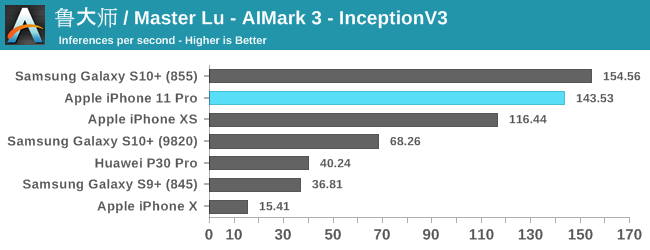
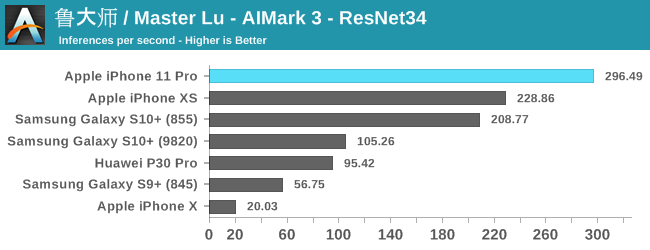
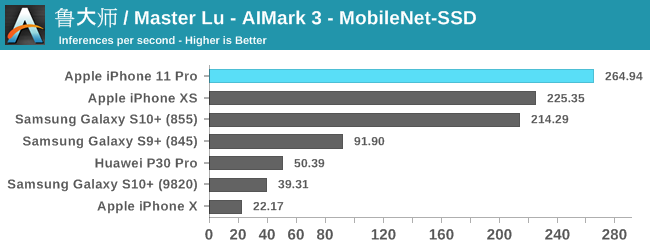
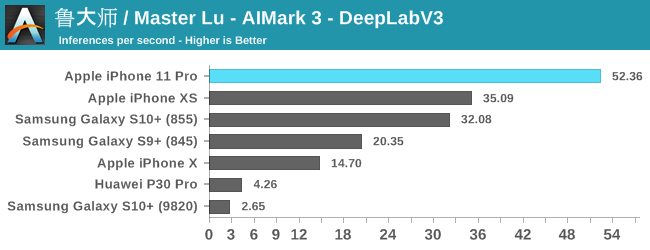
The improvements for the iPhone 11 and the new A13 vary depending on the model and workload. For the classical models such as InceptionV3 and ResNet34, we’re seeing 23-29% improvements in the inference rate. MobileNet-SSD sees are more limited 17% increase, while DeepLabV3 sees a major increase of 48%.
Generally, the issue of running machine learning benchmarks is that it’s running through an abstraction layer, in this case which is CoreML. We don’t have guarantees on how much of the model is actually being run on the NPU versus the CPU and GPU, as things can differ a lot depending on the ML drivers of the device.
Nevertheless, the A13 and iPhone 11 here are very competitive and provide good iterative performance boosts for this generation.
Performance Conclusion
Overall, performance on the iPhone 11s is excellent, as we've come to expect time and time again from Apple. With that said, however, I can’t really say that I notice too much of a difference to the iPhone XS in daily usage. So while the A13 delivers class leading performance, it's probably not going to be very compelling for users coming from last year's A12 devices; the bigger impact will be felt coming from older devices. Otherwise, with this much horsepower I feel like the user experience would benefit significantly more from an option to accelerate application and system animations, or rather even just turn them off completely, in order to really feel the proper snappiness of the hardware.


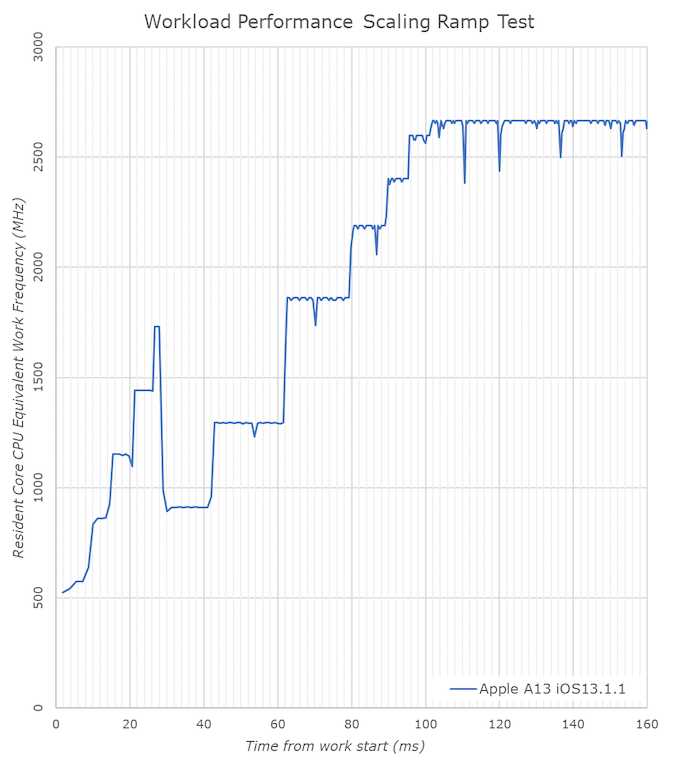








242 Comments
View All Comments
Quantumz0d - Wednesday, October 16, 2019 - link
Lol. Very funny. Just 2.5% of the screen, why not take a pencil and poke in your laptop/monitor display and say just a 0.3% like Samsung HOLED or this dead pixel zone. And put an RGB strip around/inside it to make it similar to S10 Hole notification led.A phone's primary component is Display which allows for man-machine interface, and if that itself is ruined no matter how much value the device has, it is a complete waste. Even Google realized this after their horrible Watertub 3XL disaster notch.
Notch, Hole are worse than an Asymmetric bezel on Pixel 4 and Symmetric bezels are much better to look at - V30, ROG II, Note 8, S8 while S9 and Note9, OP7 Pro, Zenfone 6, Nex have asymmetric design but they are fine over the dreaded Notch abomination or holes anyday anytime.
Apple did this crazy thing in 21 century. If engineers from CRT era were there they'd be laughing like no tomorrow. Kudos to Apple for creating something utter miserable and complete bullshit.
Why didn't the CMOS sensors / Panavision or any Film cameras or any Display shape have a notch/hole or any. Or our eyes or any animal eyes, even the insects like spiders with many eyes have full uninterrupted vision without no hole or notch in their eyes, hell even mirrors ? Until this POS hit the market the perception of a display was perfectly uniform with no interruption, it all changed thanks to Apple. They should be ashamed of creating the worst abomination while claiming the best industrial design.
"Sir" Jony Ive should be ashamed of his Knighthood lmao. Wonder he left because of Apple that he couldn't stand this Notchabomination as a black mark on his life forever (Also not note, since Chief Design Officer role doesn't exist anymore and the design teams report to Operations COO, It's interesting as if Andrei says this is the last Notch BS from Apple or whether we will see a smaller notch in 2020 lol)
uhuznaa - Thursday, October 17, 2019 - link
You have a literal blind spot in your eye where the optical nerve passes through the retina. Really. You just don't see it because it's always there. Same as with the notch by the way...Quantumz0d - Thursday, October 17, 2019 - link
No man stop convincing yourself, Retina blind spot is not notch lol. 210 Degree FoV and a blind spot how can you relate these ? Insane.uhuznaa - Thursday, October 17, 2019 - link
OK, so then just put a piece of black tape on the parts of the screen left and right of the notch and you have a bezel instead if you like this better.Seriously, what's so bad about having a bezel on top that still displays a clock and a few status symbols in the left and right corners? Exactly this is what the notch is. It just means using parts of the bezel in a limited but still useful way. I really don't understand what you notch-haters want instead of a notch. A full-width notch (aka "bezel")? Why would this be better? It would just push the status bar down, leaving less room for actual content for apps.
WinterCharm - Thursday, October 17, 2019 - link
The notch is the only weak excuse some Android fanboys have to convince themselves about why they can't move to iPhone.willis936 - Friday, October 18, 2019 - link
The space is virtually useless and makes for a more difficult user experience. Nothing is gained by forcing information into a tiny nook or to have the user need to stretch to hit a small target. Just keep the display a rectangle. It just works.Quantumz0d - Sunday, October 20, 2019 - link
Exactly, but look at the Apple apologists they will buy excuse for whatever they seem fit to make the company look great. Any wrong pointing bam personal attacks, eh. New low for AT commenters to be honest. "Insecure Android phone" these noobs do not know how an Israeli company deals with breaking smartphones. Idiots. Only god can help them.Anand2019 - Monday, October 21, 2019 - link
"Only god can help them". What does a fantasy figure have to do with this? Maybe santa can help them too?Xyler94 - Thursday, October 17, 2019 - link
Every time I look at my mother's iPhone X, the first thing that pops into my mind is "why do people fuss so much about the notch?"It's barely noticeable when you use it. It's just like your nose. your brain will ignore your nose when you're looking, but the moment you realize your nose is in your view, you'll see it again. Same as the notch, don't even think about it, and it becomes a non-factor.
Total Meltdowner - Thursday, October 17, 2019 - link
ahahahahahahahahaahAHAhahaha!